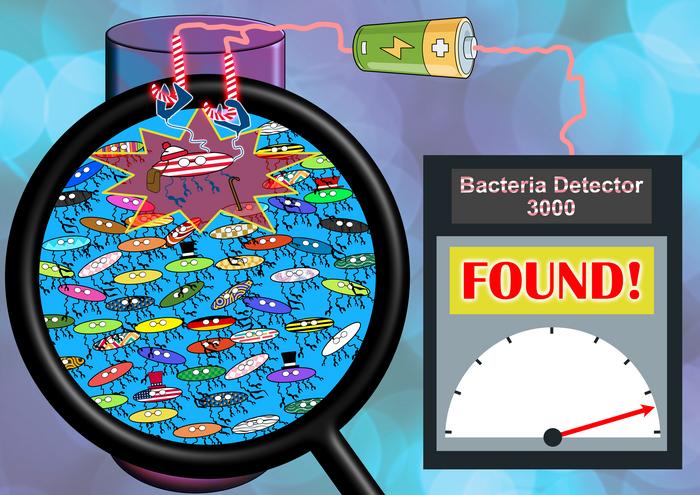Each year, bacterial infections claim several million lives worldwide. That is why detecting harmful microorganisms is crucial – not only in the diagnosis of diseases but also, for example, in food production. However, the methods available so far are often time-consuming, require expensive equipment or can only be used by specialists. Moreover, they are often unable to distinguish between active bacteria and their decay products.

Credit: Diagram: Sebastian Balser, Andreas Terfort Research Group, Goethe University Frankfurt
Each year, bacterial infections claim several million lives worldwide. That is why detecting harmful microorganisms is crucial – not only in the diagnosis of diseases but also, for example, in food production. However, the methods available so far are often time-consuming, require expensive equipment or can only be used by specialists. Moreover, they are often unable to distinguish between active bacteria and their decay products.
By contrast, the newly developed method detects only intact bacteria. It makes use of the fact that microorganisms only ever attack certain body cells, which they recognize from the latter’s specific sugar molecule structure. This matrix, known as the glycocalyx, differs depending on the type of cell. It serves, so to speak, as an identifier for the body cells. This means that to capture a specific bacterium, we need only to know the recognizable structure in the glycocalyx of its preferred host cell and then use this as “bait”.
This is precisely what the researchers have done. “In our study, we wanted to detect a specific strain of the gut bacterium Escherichia coli – or E. coli for short,” explains Professor Andreas Terfort from the Institute of Inorganic and Analytical Chemistry at Goethe University Frankfurt. “We knew which cells the pathogen usually infects. We used this to coat our chip with an artificial glycocalyx that mimics the surface of these host cells. In this way, only bacteria from the targeted E. coli strain adhere to the sensor.”
E. coli has many short arms, known as pili, which the bacterium uses to recognize its host’s glycocalyx and cling onto it. “The bacteria use their pili to bind to the sensor in several places, which allows them to hang on particularly well,” says Terfort. In addition, the chemical structure of the artificial glycocalyx is such that microbes without the right arms slide off it – like an egg off a well-greased frying pan. This ensures that indeed only the pathogenic E. coli bacteria are retained.
But how were the scientists able to corroborate that bacteria really were attached to the artificial glycocalyx? “We bonded the sugar molecules to a conductive polymer,” explains Sebastian Balser, a doctoral researcher under Professor Terfort and the first author of the paper. “By applying an electrical voltage via these ‘wires’, we are able to read how many bacteria had bonded to the sensor.”
The study documents how effective this is: The researchers mixed pathogens from the targeted E. coli strain among harmless E. coli bacteria in various concentrations. “Our sensor was able to detect the harmful microorganisms even in very small quantities,” explains Terfort. “What’s more, the higher the concentration of the targeted bacteria, the stronger the emitted signals.”
The paper is initial proof that the method works. In the next step, the involved working groups want to investigate whether it also stands the test in practice. Using it in regions where there are no hospitals with sophisticated lab diagnostics is conceivable, for example.
Picture download:
https://www.puk.uni-frankfurt.de/151323552?
Caption: By using a customized surface to bait the targeted pathogens, they separate by themselves from a mixture of many different bacteria. This makes it easy to detect them electrochemically.
Diagram: Sebastian Balser, Andreas Terfort Research Group, Goethe University Frankfurt
Further information
Professor Andreas Terfort
Institute of Inorganic and Analytical Chemistry
Goethe University Frankfurt
Tel.: +49 (0)69 798-29181
[email protected]
Website: https://www.uni-frankfurt.de/53459866/Arbeitskreis_Prof__Andreas_Terfort
Twitter/X: @goetheuni
Journal
ACS Applied Materials & Interfaces
DOI
10.1021/acsami.3c14387
Method of Research
Experimental study
Subject of Research
Cells
Article Title
Selective Quantification of Bacteria in Mixtures by Using Glycosylated Polypyrrole/Hydrogel Nanolayers
Article Publication Date
20-Mar-2024




